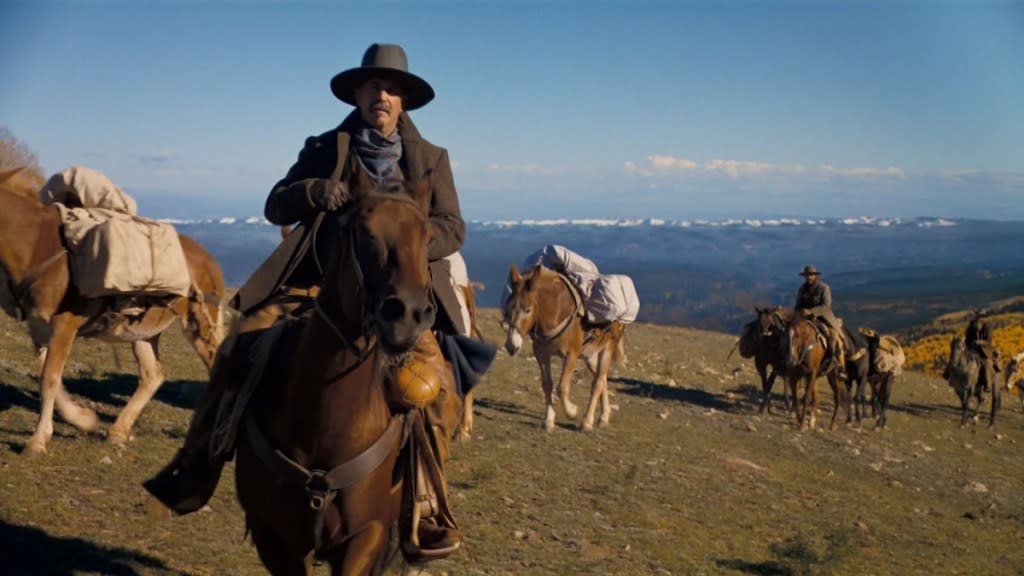‘Horizon: An American Saga’ Review: Kevin Costner Unveils a Sprawling, Old-Fashioned Western

For the last two years in a row, one of the major premieres at the Cannes Film Festival has been a mainstream film that works with the trappings and tropes of the Western genre. But there’s not much connection between Martin Scorsese’s Oklahoma-set 1920s period piece “Killers of the Flower Moon,” one of the hits of last year’s festival, and Kevin Costner’s “Horizon: An American Saga,” which had its premiere at the Grand Theatre Lumiere on Sunday evening.
For Scorsese, approaching that location and time period meant thinking hard about what he could bring to a genre that he felt had peaked with directors like John Ford and Howard Hawks in the 1940s and ’50s, and essentially been ended by Sam Peckinpah’s revisionist Western “The Wild Bunch” in the late 1968s.
Costner, though, has little interest in revisionist thinking about the genre; “Horizon” is proudly, gloriously old-fashioned, a Western for those who bemoan that they don’t make ’em like that anymore. They do, if the they is Kevin Costner.
“Horizon” is big and bold and majestic, with cinematographer J. Michael Muro capturing those expansive Utah vistas and John Debney’s score making sure that the film sounds just like the Westerns that play in the heads of everybody who was ever fond of the genre prior to its revamping at the hands of Sergio Leone, Pekinpah and their ilk. Yes, it can be corny, and at times you long for the fresh spin applied to the genre by movies like “The Unforgiven” or Costner’s own 2003 Western “Open Range” – or, for that matter, Potsy Ponciroli’s 2021 drama “Old Henry,” in which Ponciroli and actor Tim Blake Nelson use the mythology of the Old West to brilliant effect.
But “Old Henry” was a small indie movie, and there’s nothing remotely small about “Horizon.” It’s three hours and one minute long, the exact same running time as Costner’s most famous and successful directorial achievement, the Oscar-winning Western “Dances With Wolves” – and at the end of those three hours, the story is just getting started. In Cannes, Costner showed Chapter 1 of the film, which will be released by Warner Bros. in late June; a second film, Chapter 2, is coming into theaters in mid-August, with Chapters 3 and 4 written and in the works.
This is a sprawling epic with a cast of hundreds spanning decades before and after the Civil War, which means Chapter 1 has to do a lot of heavy lifting to set up who’s who, what they want and where they might be going. To his credit, Costner doesn’t let the introductions get in the way: The film starts with blasts of action as a group of settlers builds homes on a river in Apache territory and endures attacks from the indigenous people. In one neat trick, we learn lots of details about the characters in the middle of a huge action sequence when Apache warriors burn the settlement to the ground.
It isn’t until that sequence has ended, a good 20 minutes or so into the film, that Costner begins to lay the groundwork for individual plotlines. The film jumps around from one location to another to introduce key members of the ensemble cast: Sienna Miller and Georgia MacPhail as a mother and daughter who have a harrowing escape from the attack; Danny Huston, Michael Rooker and Sam Worthington as military men tasked with defending settlers who are encroaching on indigenous land; Jamie Campbell Bower and Job Beavers as the very bad Sykes brothers, and a barely-seen Dale Dickey as what seems to be their even worse mother; and Costner himself as Hayes Ellison, who you might have guessed is quiet, strong, moral and very difficult to beat in a gunfight.
That list just scratches the surface, and at times it appears that servicing all the storylines is the trickiest and least successful of Costner’s chores. World-building is, perhaps, the curse of any Chapter 1 in what will be a multi-part series; by the time you get all the pieces moving, it’s time to wrap things up with a lengthy and rousing montage that makes it look as if a lot of stuff is going to happen in Chapter 2.
You also can’t help but wonder if the indigenous characters are going to get more screen time in subsequent chapters. In the first hour or so, “Horizon” looks as if Costner is making a concerted effort to develop their characters, shifting the action to their villages for a stretch or two. But by the halfway point, the Apaches and other Native Americans have largely disappeared from the story except as foes, though it’s easy to root for rather than against them in one particular battle.
But it’s risky to look at any particular thing in “Horizon” and think that the movies will remain that way in subsequent episodes. The rhythms of Costner’s film are the rhythms of an epic TV miniseries, albeit one chocked full of all the things its creator loved about big-screen Westerns.
It’s not the kind of movie that often comes to Cannes, and Costner is altogether too taciturn a man to embrace the festival’s tradition of de rigeur extended standing ovations at all premieres. Few directors have looked less comfortable with the pre-show Standing O than Costner, who grinned sheepishly and spun his index finger as if to say, “roll the movie now.”
And afterwards, as the ovation stretched on and on, he teared up as he thanked the audience, before getting to the point. “There’s three more,” he promised.
The post ‘Horizon: An American Saga’ Review: Kevin Costner Unveils a Sprawling, Old-Fashioned Western appeared first on TheWrap.

